什么是跨域?
同源策略
跨域问题其实就是浏览器的同源策略所导致的。同源策略是一个重要的安全策略,它用于限制一个 origin 的文档或者它加载的脚本如何能与另一个源的资源进行交互。它能帮助阻隔恶意文档,减少可能被攻击的媒介。
当跨域时会收到以下错误:

跨域是浏览器还是服务器的限制? 当一个跨域请求在浏览器端发送出去后,后端服务会收到的请求并且也会处理和响应,只不过浏览器在解析这个请求的响应之后,发现不满足浏览器的同源策略(协议、域名和端口号均相同),也没有包含正确的 CORS 响应头,就拦截了这个响应。
怎么样算是同源
那么如何才算是同源呢?先来看看 url 的组成部分:
http://www.example.com:80/path/to/myfile.html?key1=value1&key2=value2#SomewhereInTheDocument

只有当 protocol(协议)、domain(域名)、port(端口)三者一致时才是同源,后面的请求路径、请求参数、锚点可以不一致。
接下来看几个例子:
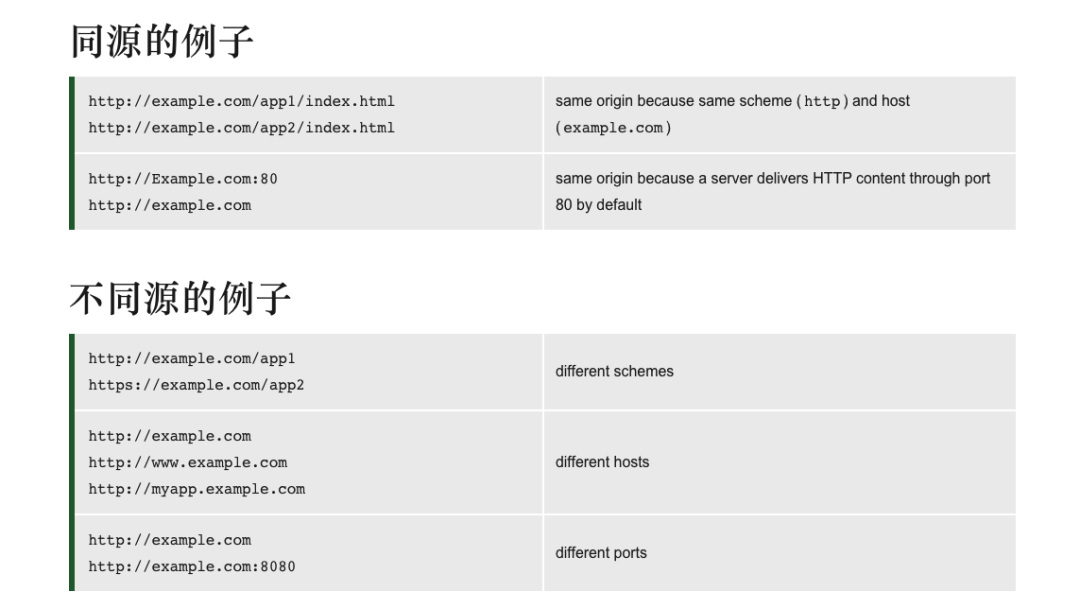
跨域示例
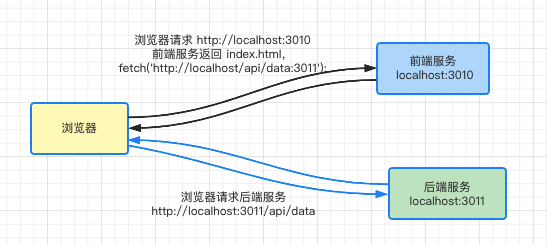
设置前端服务
创建 index.html 使用 fetch 调用 http://127.0.0.1:3011/api/data
<html>
<body>
<script>
fetch('http://127.0.0.1:3011/api/data');
</script>
</body>
</html>
创建 client.js 用来加载上面 index.html。监听 3010 端口。
const http = require('http');
const fs = require('fs');
const PORT = 3010;
http.createServer((req, res) => {
fs.createReadStream('index.html').pipe(res);
}).listen(PORT);
console.log('Server listening on port ', PORT);
启动前端服务:
node client.js
设置后端服务
创建 server.js 开启一个服务,提供一个访问的接口 api/data,监听 3011 端口。
const http = require('http');
const PORT = 3011;
http.createServer((req, res) => {
const url = req.url;
console.log('request url: ', url);
if (url === '/api/data') {
return res.end('console.log("hello world!");');
}
}).listen(PORT);
console.log('Server listening on port ', PORT);
启动后端服务:
node server.js
在浏览器上访问前端服务 http://localhost:3010/ ,在请求头里可以看到有 Origin 字段,显示了我们当前的请求源信息。另外还有三个 Sec-Fetch-* 开头的字段,这是一个新的草案 Fetch Metadata Request Headers。
Sec-Fetch-Mode: cors
表示的是这是个跨域请求。
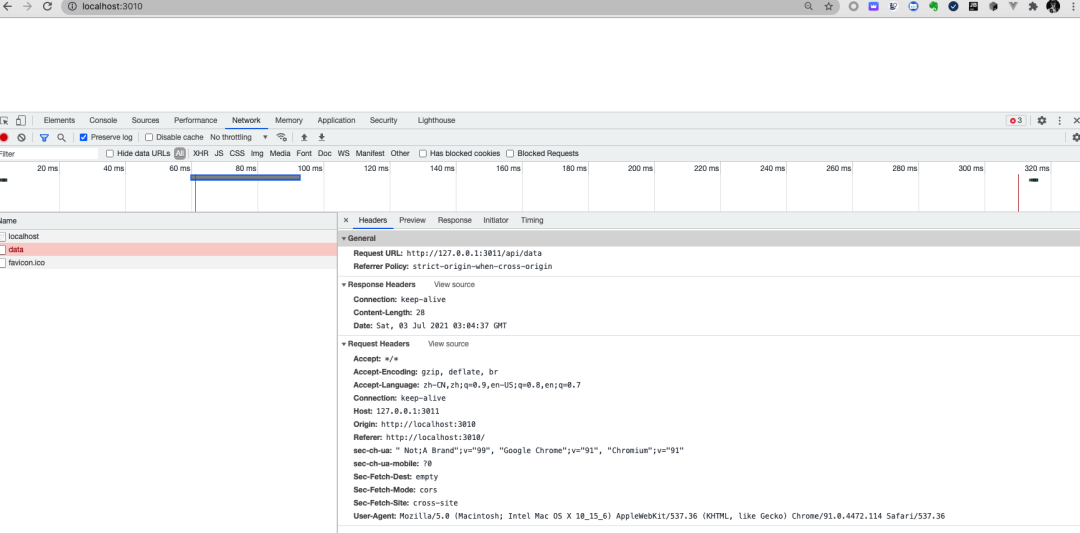
看下浏览器 Console 下的日志信息,根据提示得知原因是从 “http://127.0.0.1:3010” 访问 “http://127.0.0.1:3011/api/data” 被 CORS 策略阻止了,因为没有 “Access-Control-Allow-Origin” 标头。

再看下后端服务的输出,可以看到后端服务收到并且正常响应了请求,只不过浏览器在解析这个请求的响应之后,发现不满足浏览器的同源策略(协议、域名和端口号均相同),也没有包含正确的 CORS 响应头,就拦截了这个响应。
Server listening on port 3011
request url: /api/data
本节代码示例:
https://github.com/cr7258/cors-lab/tree/master/cross-origin
CORS(跨域资源共享)
跨源资源共享 (CORS,Cross-origin resource sharing)是一种基于 HTTP 头的机制,该机制通过允许服务器标示除了它自己以外的其它 origin(域,协议和端口),这样浏览器可以访问加载这些资源。
预检请求
预检请求是在发送实际的请求之前,前端服务会先发送一个 OPTIONS 方法的请求向服务器确认,如果通过之后,浏览器才会发起真正的请求,这样可以避免跨域请求对服务端的数据造成影响。
看到这里你可能有疑问为什么上面的示例没有预检请求?因为 CORS 将请求分为了两类:简单请求和非简单请求。我们上面的情况属于简单请求,所以也就没有了预检请求。
让我们继续在看下简单请求和非简单请求是如何定义的。
简单请求
不会触发 CORS 预检请求。这样的请求为“简单请求”。若请求满足所有下述条件,则该请求可视为“简单请求”:
情况一: 使用以下方法(意思就是以下请求意外的都是非简单请求) GET HEAD POST 情况二: 人为设置以下集合外的请求头 Accept Accept-Language Content-Language Content-Type(需要注意额外的限制) DPR Downlink Save-Data Viewport-Width Width 情况三:Content-Type 的值仅限于下列三者之一:(例如 application/json 为非简单请求) text/plain multipart/form-data application/x-www-form-urlencoded 情况四: 请求中的任意 XMLHttpRequestUpload 对象均没有注册任何事件监听器;XMLHttpRequestUpload 对象可以使用 XMLHttpRequest.upload 属性访问。 情况五: 请求中没有使用 ReadableStream 对象。
非简单请求
除了简单请求以外的都是非简单请求。
预检请求示例
设置前端服务
为 index.html 里的 fetch 方法增加一些设置,设置请求的方法为 PUT,请求头增加一个自定义字段 Test-Cors。
<script>
fetch('http://127.0.0.1:3011/api/data', {
method: 'PUT',
headers: {
'Content-Type': 'text/plain',
'Test-Cors': 'abc'
}
});
</script>
上述代码在浏览器执行时会发现是一个非简单请求,就会先执行一个预检请求,Request Headers 会有如下信息:
OPTIONS /api/data HTTP/1.1
Host: 127.0.0.1:3011
Access-Control-Request-Method: PUT
Access-Control-Request-Headers: content-type,test-cors
Origin: http://127.0.0.1:3010
Sec-Fetch-Mode: cors
可以看到有一个 OPTIONS 是预检请求使用的方法,该方法是在 HTTP/1.1 协议中所定义的,还有一个重要的字段 Origin 表示请求来自哪个源,后端服务则可以根据这个字段判断是否是合法的请求源。
Access-Control-Request-Method 告诉服务器,实际请求将使用 PUT 方法。Access-Control-Request-Headers 告诉服务器,实际请求将使用两个头部字段 Content-Type,Test-Cors。这里如果 Content-Type 指定的为简单请求中的几个值,Access-Control-Request-Headers 在告诉服务器时,实际请求将只有 Test-Cors 这一个头部字段。
设置后端服务
上面讲解了前端服务的设置,同样的要使请求能够正常响应,还需后端服务的支持。修改我们的 server.js 重点是设置 Response Headers 代码如下所示:
const http = require('http');
const PORT = 3011;
http.createServer((req, res) => {
const { url, method } = req;
console.log('request url:', url, ', request method:', method);
res.writeHead(200, {
'Access-Control-Allow-Origin': 'http://127.0.0.1:3010',
'Access-Control-Allow-Headers': 'Test-CORS, Content-Type',
'Access-Control-Allow-Methods': 'PUT,DELETE',
'Access-Control-Max-Age': 1728000
});
if (method === 'OPTIONS') {
return res.end();
}
if (method === 'PUT' && url === '/api/data') {
return res.end('ok!');
}
return res.end();
}).listen(PORT);
console.log('Server listening on port ', PORT);
首先预检请求时,浏览器给了服务器几个重要的信息 Origin、Method 为 PUT、Headers 为 Content-Type,Test-Cors 。后端服务在收到之后,也要做些设置,给予回应。
Access-Control-Allow-Origin 表示 “http://127.0.0.1:3010” 这个请求源是可以访问的,该字段也可以设置为 “*” 表示允许任意跨源请求。
Access-Control-Allow-Methods 表示服务器允许前端服务使用 PUT、DELETE 方法发起请求,可以一次设置多个,表示服务器所支持的所有跨域方法,而不单是当前请求那个方法,这样好处是为了避免多次预检请求。
Access-Control-Allow-Headers 表示服务器允许请求中携带 Test-CORS、Content-Type 字段,也可以设置多个。
Access-Control-Max-Age 表示该响应的有效期,单位为秒。在有效时间内,浏览器无须为同一请求再次发起预检请求。还有一点需要注意,该值要小于浏览器自身维护的最大有效时间,否则是无效的。
浏览器访问 http://127.0.0.1:3010 ,第一次先发出了 OPTIONS 请求,并且在请求头设置了本次请求的方法和 Headers 信息,后端服务在 Response 也做了回应,在 OPTIONS 成功之后,浏览器紧跟着才发起了我们本次需要的真实请求,如图右侧所示 Resquest Method 为 PUT。
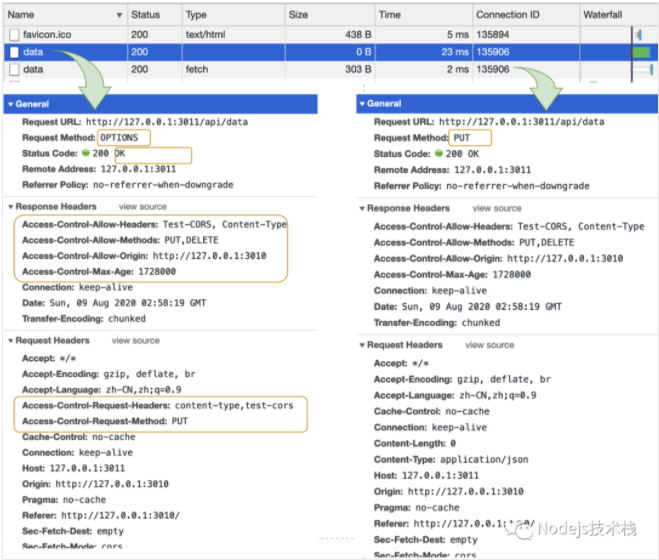
注意这里访问 127.0.0.1:3010 和 localhost:3010 是不一样的,因为我们在后端服务设置的是 'Access-Control-Allow-Origin': 'http://127.0.0.1:3010'
。如果浏览器访问 http://localhost:3010 ,由于不满足服务端设置允许的跨域源地址,服务端的响应将会被浏览器拦截。
本节代码示例:
https://github.com/cr7258/cors-lab/tree/master/options
CORS 与认证
对于跨域的 XMLHttpRequest 或 Fetch 请求,浏览器是不会发送身份凭证信息的。例如我们要在跨域请求中发送 Cookie 信息,就要做些设置:
为了能看到效果,我先自定义了一个 cookie 信息 id=NodejsRoadmap。
重点是设置认证字段,本文中 fetch 示例设置 credentials: "include" 如果是 XMLHttpRequest 则设置 withCredentials:"include"
<body>
<script>
//设置 Cookie 信息
document.cookie = `id=NodejsRoadmap`;
fetch('http://127.0.0.1:3011/api/data', {
method: 'PUT',
headers: {
'Content-Type': 'application/json',
'Test-Cors': 'abc',
},
credentials: "include"
});
</script>
</body>
经过以上设置,浏览器发送实际请求时会向服务器发送 Cookies,同时服务器也需要在响应中设置 Access-Control-Allow-Credentials 响应头。
const http = require('http');
const PORT = 3011;
http.createServer((req, res) => {
const { url, method } = req;
console.log('request url:', url, ', request method:', method);
res.writeHead(200, {
'Access-Control-Allow-Origin': 'http://127.0.0.1:3010',
'Access-Control-Allow-Headers': 'Test-Cors, Content-Type',
'Access-Control-Allow-Methods': 'PUT,DELETE',
'Access-Control-Max-Age': 1728000,
//允许发送认证信息
'Access-Control-Allow-Credentials': true
});
if (method === 'OPTIONS') {
return res.end();
}
if (method === 'PUT' && url === '/api/data') {
return res.end('ok!');
}
return res.end();
}).listen(PORT);
console.log('Server listening on port ', PORT);
浏览器访问 http://127.0.0.1:3010,第一次发送 OPTIONS 请求,后端服务返回 Access-Control-Allow-Credentials: true
允许前端服务携带认证信息。
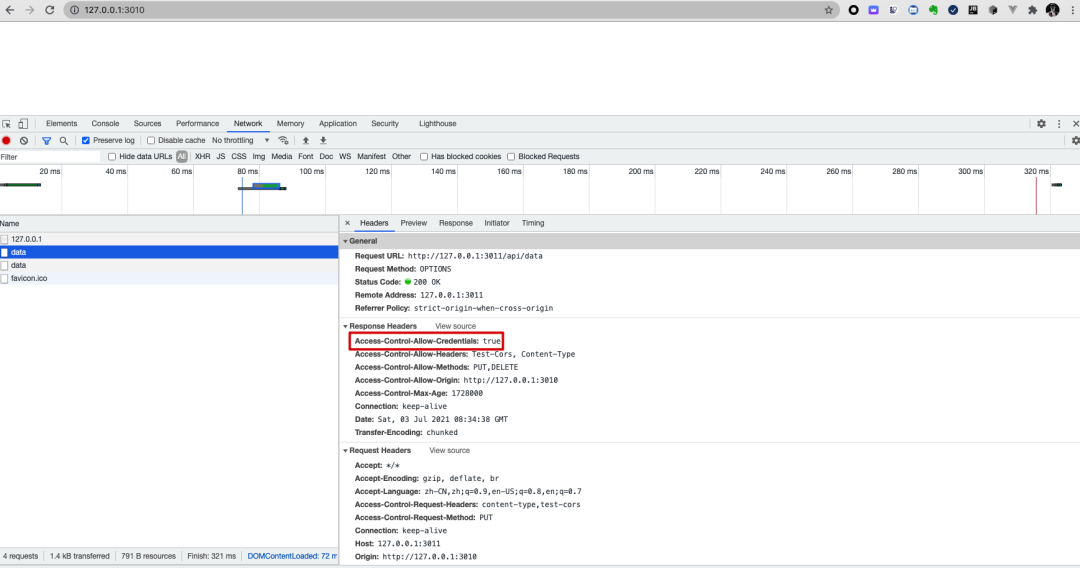
第二次发送 PUT 请求,在 Cookie 中携带 id=NodejsRoadmap。
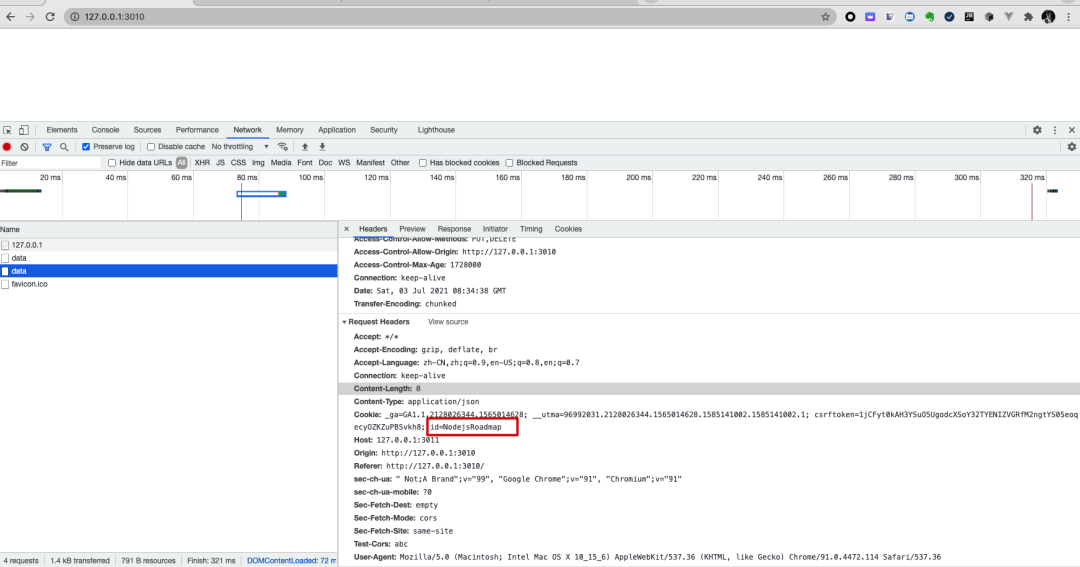
本节代码示例:
https://github.com/cr7258/cors-lab/tree/master/cookie
解决跨域
解决跨域有以下方式:
在前端服务解决跨域。 在后端服务解决跨域。 在 Nginx 等反向代理解决跨域。 Websocket。 浏览器允许跨域。
前端服务解决跨域
JSONP
JSONP 主要就是利用了 script 标签没有跨域限制的这个特性来完成的。浏览器是允许像 link、img、script 标签在路径上加载一些内容进行请求,是允许跨域的,JSONP 的实现原理就是在 script 标签里面加载了一个链接,去访问服务器的某个请求。
//index.html
<body>
<script src="http://127.0.0.1:3011/api/data"></script>
</body>
JSONP 有一个限制就是只支持 GET 请求。
本节代码示例:
https://github.com/cr7258/cors-lab/tree/master/front/jsonp
后端解决跨域
Node.js 项目
使用 CORS 模块
如果后端是使用 Node.js 编写的,可以使用 cors 模块,github 地址:github.com/expressjs/cors 。在前面的示例中,一直使用的 Node.js 原生模块来编写我们的示例,在引入 cors 模块后,可以按照如下方式改写:
// server.js
const http = require('http');
const PORT = 3011;
const corsMiddleware = require('cors')({
origin: 'http://127.0.0.1:3010',
methods: 'PUT,DELETE',
allowedHeaders: 'Test-Cors, Content-Type',
maxAge: 1728000,
credentials: true,
});
http.createServer((req, res) => {
const { url, method } = req;
console.log('request url:', url, ', request method:', method);
const nextFn = () => {
if (method === 'PUT' && url === '/api/data') {
return res.end('ok!');
}
return res.end();
}
corsMiddleware(req, res, nextFn);
}).listen(PORT);
console.log('Server listening on port ', PORT);
cors 在预检请求之后或在预检请求里并选项中设置了 preflightContinue 属性之后才会执行 nextFn 这个函数,如果预检失败就不会执行 nextFn 函数。
本节代码示例:
https://github.com/cr7258/cors-lab/tree/master/backend/cors
SpringBoot 项目
现在后端项目大部分使用 SpringBoot 编写的,接下来介绍 3 种在 SpringBoot 设置跨域的方式。
方式一:使用 CorsFilter 进行全局跨域配置
package com.chengzw.config;
import org.springframework.context.annotation.Bean;
import org.springframework.context.annotation.Configuration;
import org.springframework.web.cors.CorsConfiguration;
import org.springframework.web.cors.UrlBasedCorsConfigurationSource;
import org.springframework.web.filter.CorsFilter;
/***
* @author chengzw
* @description 后端解决跨域方式一
* @since 2021/7/1
*/
@Configuration
public class CorsConfig {
private CorsConfiguration buildConfig() {
CorsConfiguration corsConfiguration = new CorsConfiguration();
// 你需要跨域的地址 注意这里的 127.0.0.1 != localhost
// * 表示对所有的地址都可以访问
corsConfiguration.addAllowedOrigin("*");
// 跨域的请求头
corsConfiguration.addAllowedHeader("*");
// 跨域的请求方法
corsConfiguration.addAllowedMethod("*");
//加上了这一句,大致意思是可以携带 cookie
//最终的结果是可以 在跨域请求的时候获取同一个 session
corsConfiguration.setAllowCredentials(true);
return corsConfiguration;
}
@Bean
public CorsFilter corsFilter() {
UrlBasedCorsConfigurationSource source = new UrlBasedCorsConfigurationSource();
//配置可以访问的路径
source.registerCorsConfiguration("/**", buildConfig()); // 4
return new CorsFilter(source);
}
}
方式二:重写 WebMvcConfigurer 的 addCorsMappings方法(全局跨域配置)
package com.chengzw.config;
import org.springframework.context.annotation.Configuration;
import org.springframework.web.servlet.config.annotation.CorsRegistry;
import org.springframework.web.servlet.config.annotation.WebMvcConfigurer;
/**
* @author chengzw
* @description 后端解决跨域方式二
* @since 2021/7/3
*/
@Configuration
public class WebMvcConfg implements WebMvcConfigurer {
@Override
public void addCorsMappings(CorsRegistry registry) {
//设置允许跨域的路径
registry.addMapping("/**")
//设置允许跨域请求的域名
//当**Credentials为true时,**Origin不能为星号,需为具体的ip地址【如果接口不带cookie,ip无需设成具体ip】
.allowedOrigins("http://127.0.0.1:3010")
//是否允许证书 不再默认开启
.allowCredentials(true)
//设置允许的方法
.allowedMethods("*")
//跨域允许时间
.maxAge(3600);
}
}
方式三:使用CrossOrigin注解(局部跨域配置)
@CrossOrigin 注解是 Springboot 自带的,使用比较简单,只需要在支持的跨域的接口上加上这个注解就可以了。
将 @CrossOrigin 注解加在 Controller 层的方法上,该方法定义的 RequestMapping 端点将支持跨域访问。
将 @CrossOrigin 注解加在 Controller 层的类定义处,整个类所有的方法对应的 RequestMapping 端点都将支持跨域访问。
package com.chengzw.controller;
import com.chengzw.service.HelloService;
import org.springframework.beans.factory.annotation.Autowired;
import org.springframework.web.bind.annotation.CrossOrigin;
import org.springframework.web.bind.annotation.RequestMapping;
import org.springframework.web.bind.annotation.RestController;
/**
* @author chengzw
* @description
* @since 2021/7/3
*/
@RestController
public class HelloController {
@Autowired
HelloService helloService;
// 后端解决跨域问题方式三,使用该注解就注释 CrosConfig 和 WebMvcConfig,@CrossOrigin(origins = "*",allowCredentials="true",allowedHeaders = "*",methods = {})
@CrossOrigin
@RequestMapping("/api/data")
public String hello(){
return helloService.hello();
}
}
本节代码示例:
https://github.com/cr7258/cors-lab/tree/master/backend/springboot
Nginx 解决跨域
方式一:添加跨域 HTTP 头部
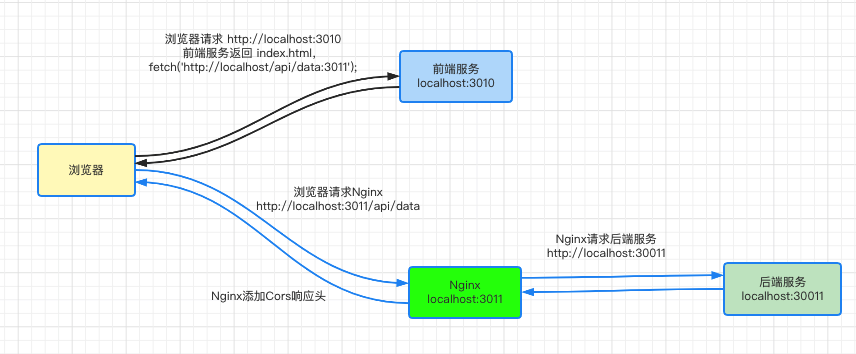
原本浏览器是访问 localhost:3011/api/data 请求后端服务的接口,现在让 Nginx 监听 3011 端口,把请求转发到后端服务新的端口 30011 上。Nginx 接收到后端服务的响应后,添加相关的 CORS 头部返回给浏览器。
Nginx 配置文件
events {}
http {
server {
listen 3011;
server_name localhost;
location {
if ($request_method = 'OPTIONS') {
add_header 'Access-Control-Allow-Origin' 'http://127.0.0.1:3010';
add_header 'Access-Control-Allow-Methods' 'PUT,DELETE';
add_header 'Access-Control-Allow-Headers' 'Test-CORS, Content-Type';
add_header 'Access-Control-Max-Age' 1728000;
add_header 'Access-Control-Allow-Credentials' 'true';
add_header 'Content-Length' 0;
return 204;
}
#Access-Control-Allow-Origin是必须的,其他可选
add_header 'Access-Control-Allow-Origin' 'http://127.0.0.1:3010';
add_header 'Access-Control-Allow-Credentials' 'true';
proxy_pass http://127.0.0.1:30011;
proxy_set_header Host $host;
}
}
}
proxy_set_header 和 add_header 的区别?
proxy_set_header 是 Nginx 设置请求头信息给上游服务器,add_header 是 Nginx 设置响应头信息给浏览器。
启动 Nginx:
/usr/local/nginx/sbin/nginx -c ~/Code/github/cors-lab/nginx/nginx-add-header/nginx.conf
本节代码示例:
https://github.com/cr7258/cors-lab/tree/master/nginx/nginx-add-header
方式二:让前端服务和后端服务接口同域
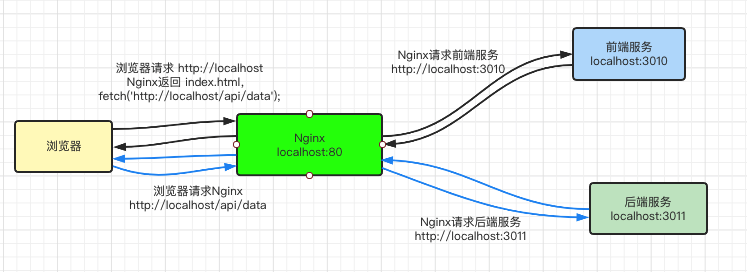
Nginx 对浏览器暴露统一的端口号 80,根据不同的请求请求路径区分前端服务和后端服务。这样可以保证浏览器不管访问前端服务还是后端服务,看到的都是 http://localhost。
Nginx 配置文件
server {
listen 80;
server_name localhost;
#前端服务
location {
proxy_pass http://localhost:3010;
}
#后端服务接口地址
location api/data {
proxy_pass http://localhost:3011;
}
}
修改前端服务
<html>
<body>
<script>
//修改请求后端服务的地址,端口号改成 Nginx 监听的 80 端口
fetch('http://127.0.0.1/api/data');
</script>
</body>
</html>
启动 Nginx:
/usr/local/nginx/sbin/nginx -c ~/Code/github/cors-lab/nginx/nginx-same-site/nginx.conf
本节代码示例:
https://github.com/cr7258/cors-lab/tree/master/nginx/nginx-same-site
Websocket
WebSocket 规范定义了一种 API,可在网络浏览器和服务器之间建立“套接字”连接。简单来说浏览器和后端服务之间建立长连接,而且双方都可以随时开始发送数据。这种方式的本质是没有使用 HTTP 的响应头, 因此也没有跨域的限制。Websock 可以参考这篇文章。
设置前端服务
<script>
const socket = new WebSocket("ws://localhost:3011");
socket.onopen = function() {
socket.send("Hello Server");
};
socket.onmessage = function(e) {
console.log(e.data);
};
</script>
const http = require('http');
const fs = require('fs');
const PORT = 3010;
http.createServer((req, res) => {
fs.createReadStream('index.html').pipe(res);
}).listen(PORT);
console.log('Server listening on port ', PORT);
设置后端服务
const PORT = 3011;
const WebSocket = require("ws");
const server = new WebSocket.Server({ port: PORT });
server.on("connection", function(socket) {
socket.on("message", function(data) {
socket.send("Hello Client");
});
});
console.log('Server listening on port ', PORT);
浏览器访问 http://127.0.0.1:3010,Websocket 是基于 HTTP 的,第一次浏览器发送 HTTP 请求,后端服务返回 101 Switching Procotols 升级 HTTP 为 Websocket。
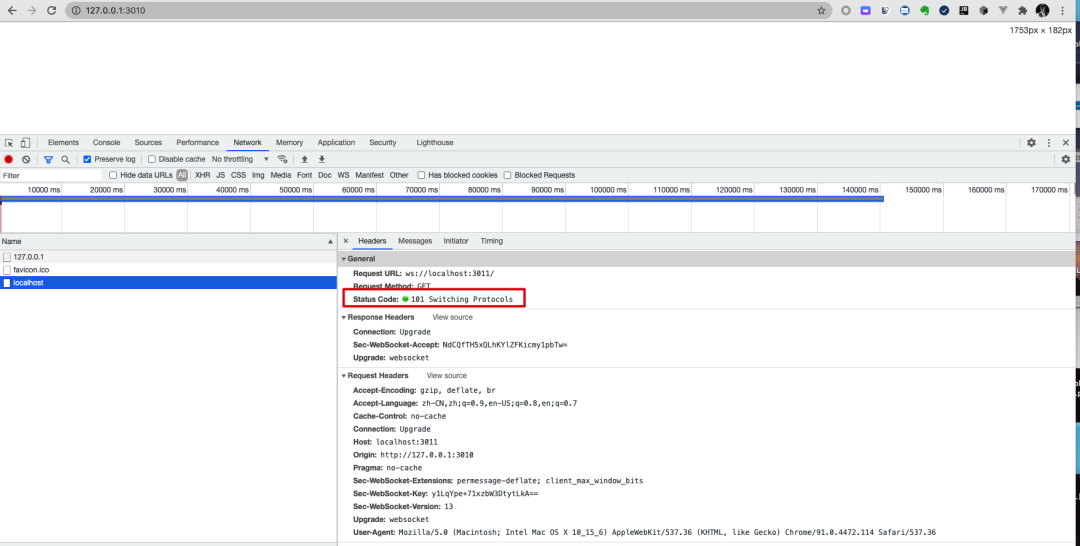
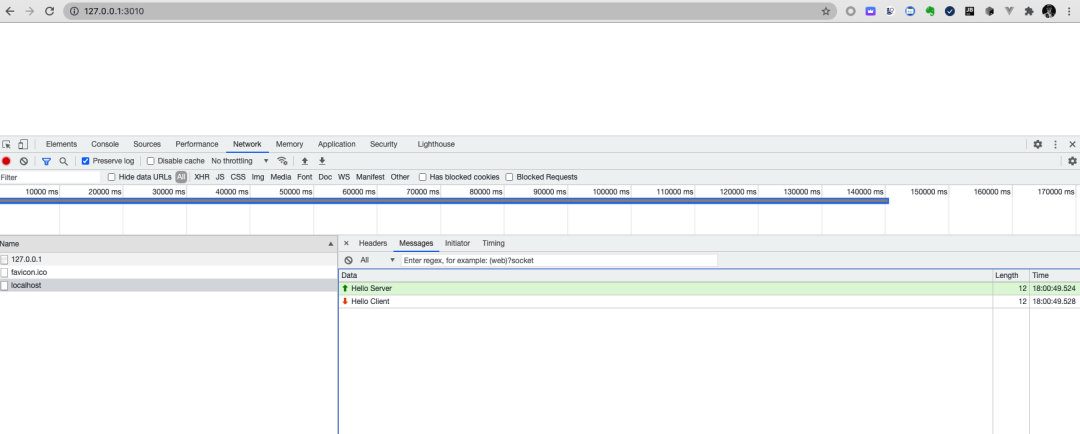
本节代码示例:
https://github.com/cr7258/cors-lab/tree/master/websocket
浏览器允许跨域
其实跨域问题是浏览器策略,源头是他,那么能否能关闭这个功能呢?答案是肯定的。
Windows 找到安装 Chrome 的目录,--user-data-dir 这个目录可以自定义。
.\Google\Chrome\Application\chrome.exe --disable-web-security --user-data-dir=xxxx
Mac
在控制台敲入下面的命令前,先关闭已经打开的所有 Chrome 浏览器窗口。
#创建临时目录
mkdir /tmp/google
#设置跨域并打开浏览器
open -a "/Applications/Google Chrome.app" --args --disable-web-security --user-data-dir=/tmp/google
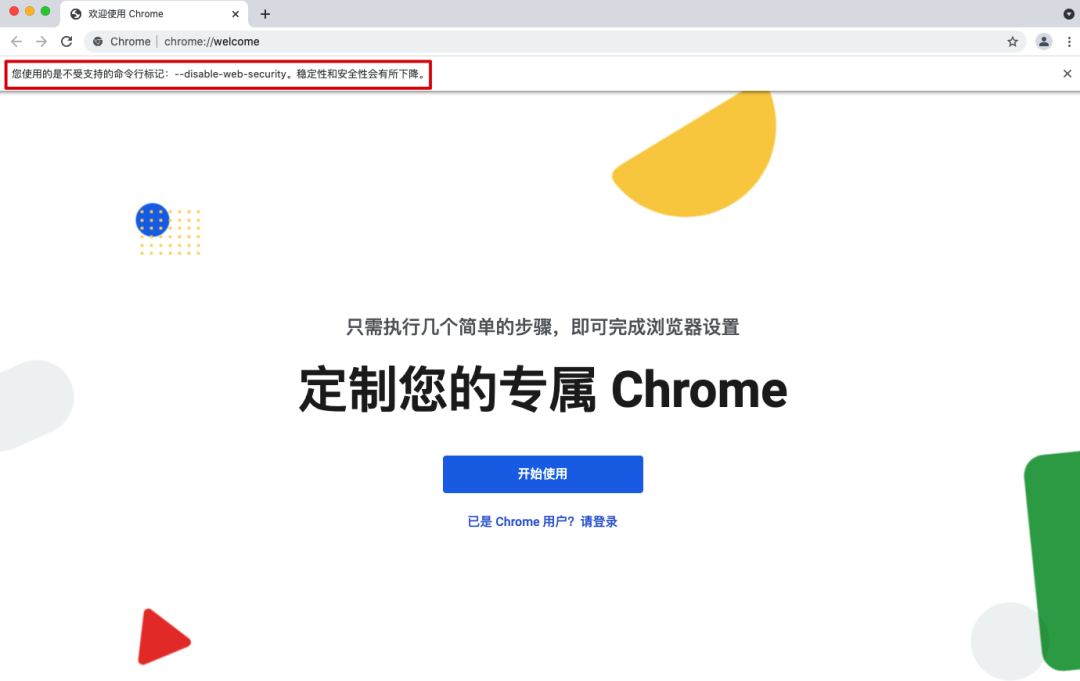
重启浏览器,如果还需要可跨域的话,依然需要通过这个命令行的形式打开,否则将通过普通的方式打开。
参考链接
https://developer.mozilla.org/zh-CN/docs/Web/HTTP/CORS https://www.jianshu.com/p/a638fb1c8b34 https://segmentfault.com/a/1190000021711445 https://segmentfault.com/a/1190000022398875 https://juejin.cn/post/6844903991558537223#heading-8






